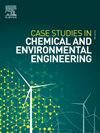Reclamation of formic acid wastewater by electro-oxidation coupled with UV irradiation (UV/EO)
Q1 Environmental Science
Case Studies in Chemical and Environmental Engineering
Pub Date : 2025-06-02
DOI:10.1016/j.cscee.2025.101247
引用次数: 0
Abstract
The research aims to reclaim formic acid wastewater using UV/EO process, compared with the electro-oxidation (EO). The UV/EO process was more effective in treatment of formic acid wastewater as the COD reduction was higher, compared with the EO alone. In addition, the UV/EO process could decrease TDS via conversion of chloride ions to chlorine. The UV/EO performance highly depended on current density (CD) and contact time, while the role of temperature was minor. The UV/EO performance was greatly enhanced with higher CDs in non-filtrated waters because of less interferences, compared with filtrated waters. Electrodes of BDD and titanium plates were robustness for the UV/EO process. The estimated treatment costs were approximately 0.5, 1.3, and 2.4 US dollar/m3 for CD at 5, 10 and 15 mA/cm2, respectively. The UV/EO process has the potential to reclaim formic acid wastewater for non-potable application. The treated water is suitable for reuse in plantation, irrigation, and cleaning, as the total coliform and fecal coliform counts were inactivated to non-detectable levels. However, pH and TDS should be monitored. This is the first study that conducts the UV/EO experiment with industrial formic acid wastewater. The finding indicates that UV/EO is an effective process for reclamation of formic acid wastewater.
电氧化-紫外辐照(UV/EO)复合处理甲酸废水
与电氧化法(EO)相比,研究了采用UV/EO法回收甲酸废水。UV/EO工艺处理甲酸废水效果好,COD的降低率高于单独使用EO工艺。此外,UV/EO工艺可以通过氯离子转化为氯来降低TDS。UV/EO性能主要受电流密度(CD)和接触时间的影响,而温度的影响较小。与过滤后的水相比,在未过滤的水中,由于干扰较少,较高的cd大大提高了UV/EO性能。BDD电极和钛板电极在UV/EO过程中具有良好的鲁棒性。估计CD在5、10和15 mA/cm2下的处理成本分别约为0.5、1.3和2.4美元/m3。UV/EO工艺具有回收甲酸废水用于非饮用水应用的潜力。处理后的水适合在种植、灌溉和清洁中重复使用,因为总大肠菌群和粪便大肠菌群计数被灭活到不可检测的水平。然而,pH和TDS应监测。这是第一次对工业甲酸废水进行紫外/EO实验。研究结果表明,UV/EO工艺是一种有效的处理甲酸废水的工艺。
本文章由计算机程序翻译,如有差异,请以英文原文为准。
求助全文
约1分钟内获得全文
求助全文
来源期刊

Case Studies in Chemical and Environmental Engineering
Engineering-Engineering (miscellaneous)
CiteScore
9.20
自引率
0.00%
发文量
103
审稿时长
40 days
 求助内容:
求助内容: 应助结果提醒方式:
应助结果提醒方式:


